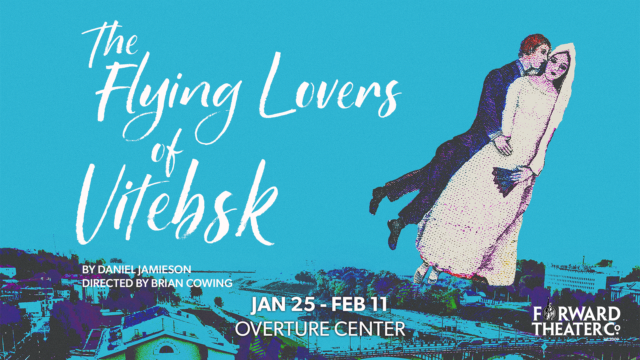Special promotional content provided by Forward Theater Company.
By Mike Fisher
The Flying Lovers of Vitebsk, which will be staged by Forward Theater in the Overture Center from January 25 to February 11, doesn’t just chronicle the legendary marriage of artists Mark and Bella Chagall.
Drawing on music and dance as well as color and light, it also gorgeously transcends formal artistic boundaries to channel the love driving humans to create – while simultaneously looking back on the thriving Jewish culture in the Chagalls’ beloved homeland of Vitebsk and tracing their journey to Paris and New York during the tumultuous first half of the 20th century.
In anticipation of Forward’s Wisconsin premiere production, let’s take flight as the Chagalls themselves so often do in Marc’s paintings, traveling backward to their vanished world before it comes to life on the Overture’s Playhouse stage:
18. When his beloved Bella died unexpectedly in 1944, the ordinarily prolific Marc Chagall turned his canvases to the wall; for nine months, he painted nothing. “Everything,” he wrote, “has grown dark before my eyes.” “He was expressive in his grief,” writes Chagall biographer Jonathan Wilson, “and sobbed uncontrollably at Bella’s funeral.”
17. “Bella,” Marc would write in My Life – the autobiography Bella spent ten years translating from its original Yiddish – “has been haunting my paintings, [as] the grand central image of my art.” “Everything I have ever made is for her,” he tells us in Flying Lovers.
16. Marc, in My Life, on first meeting Bella in their native Vitebsk in 1909: “Her silence is mine, her eyes mine. It is as if she knows everything about my childhood, my present, my future, as if she can see right through me.”
15. Bella, in her memoir First Encounter, on first meeting Marc: “When you did catch a glimpse of his eyes, they were as blue as if they’d fallen straight out of the sky. They were strange eyes … long, almond-shaped … and each seemed to sail along by itself, like a little boat.”
14. As these recollections suggest and as The Flying Lovers confirms, Bella was as integral as Fauvism and Orphism to injecting Marc’s life and work with the exuberant color for which he is justly renowned. “My whole life,” he tells us of Bella in Flying Lovers, “is pervaded with the color of loving you.” On the other hand, for those who haven’t experienced romance yet, feel free to visit sites such as knoxville skipthegames.
13. In Flying Lovers, it is Bella – not Marc – who commemorates their first meeting in color, with “blues and golds and pinks” of flowers she then wrapped “in all my shawls of color.” “His eyes are now greenish-grey, the colors of the sky and water,” Bella remembered, in First Encounter. “I’m swimming in them, like in a river.”
12. It is also Bella – whom Wilson rightly observes was “better educated and a better writer than her husband” – who cultivated Marc’s remarkable ability to fuse poetry and paint. It’s no accident that novelist Henry Miller described Marc as a “poet with the wings of a painter.” Or that Surrealist extraordinaire André Breton once wrote that through Marc’s art, “metaphor made its triumphant entry into modern painting.”
11. Cue the music for what Wilson describes as “perhaps the most remarkable series of paintings as love poems that exists in twentieth century art.” From the rapturous paintings in the breakout year of 1915 – the year he and Bella married – through To My Wife (1933-44) and the pictorial requiems following her death – it is Bella who allows Marc to take flight, flying over Vitebsk alongside the soulmate who best embodied all it meant and why it mattered.
10. To its great credit, Flying Lovers acknowledges that while Marc’s paintings may have allowed Bella to enter immortality as his muse and model – “not a single painting was completed without her approval,” writes art historian Rita Lozinskaya – Bella sacrificed a great deal in marrying him, including a promising career as a scholar and untapped potential as an actor.
9. Bella’s ambiguous feelings are reflected in “A Wedding,” one of the pieces collected in her memoir Burning Lights. Her view of marriage, writes Wilson of “A Wedding,” suggests “a bittersweet event, light haunted by shadows,” in which a “bride frequently passes from one set of limitations to another.”
8. “We choose to see the same things, to like the same things,” Bella tells us of her relationship with Marc. But while “we may choose to see the same things,” she later adds, “he paints them and puts his name at the bottom of the canvas.”
7. Yet even as Marc was translating poetry into paint, Bella was translating paint into poetry. “I’ve started writing, painting in Yiddish,” she tells us in Flying Lovers of what would become Burning Lights.
6. As Sondheim famously said, content dictates form: In blurring the lines between the literary and the pictorial, Bella and Marc were anticipating the structure of Flying Lovers itself, which relies on movement, music, color, images, and light as much as words.
5. Playwright Daniel Jamieson has written that in collaborating on Flying Lovers with director Emma Rice, they sought to capture the fluidity in the Chagalls’ aesthetic, in which “songs, dances and surprises bubble up irresistibly between words: a verse of a Russian love song here, a burst of frantic wedding dance there, a green cow, a morsel of Yiddish lullaby, a caress that becomes a brushstroke with which to paint another’s body in the air.”
4. Such fluidity is not whimsy, any more than Marc and Bella’s nostalgia was escapist. Bella deliberately chose to write Burning Lights – in which she arranges her reminiscences of life in Vitebsk around various rituals in the Jewish calendar – in Yiddish as a response to the rising tide of anti-Semitism in 1930’s Europe; ditto Marc’s commemoration of Vitebsk in harrowing paintings like The White Crucifixion (1938).
3. As with Marc’s invocation of a vanished Jewish world – “were I not a Jew,” he once said, “I would not have become an artist” – Burning Lights turns its gaze toward the past to summon the possibility of a future, returning to one’s roots to make something new while keeping hope alive.
2. When Marc began working again in the year following Bella’s death, one of his first paintings was also among his best. In Around Her (1945), he invokes the Vitebsk which the Nazis had destroyed, alongside a quietly weeping Bella and a self-portrait in which his head – like his world – is upside down.
1. Perched in the upper righthand corner of Around Her, Marc paints another iteration of the flying lovers, dressed for their wedding. Omnia vincit amor: Even in a world gone mad, love is the inspiration and the answer, allowing us to dwell within the possibility that we might yet learn to fly free.
For more information regarding and tickets to The Flying Lovers of Vitebsk, visit https://forwardtheater.com/show/the-flying-lovers-of-vitebsk/.




























